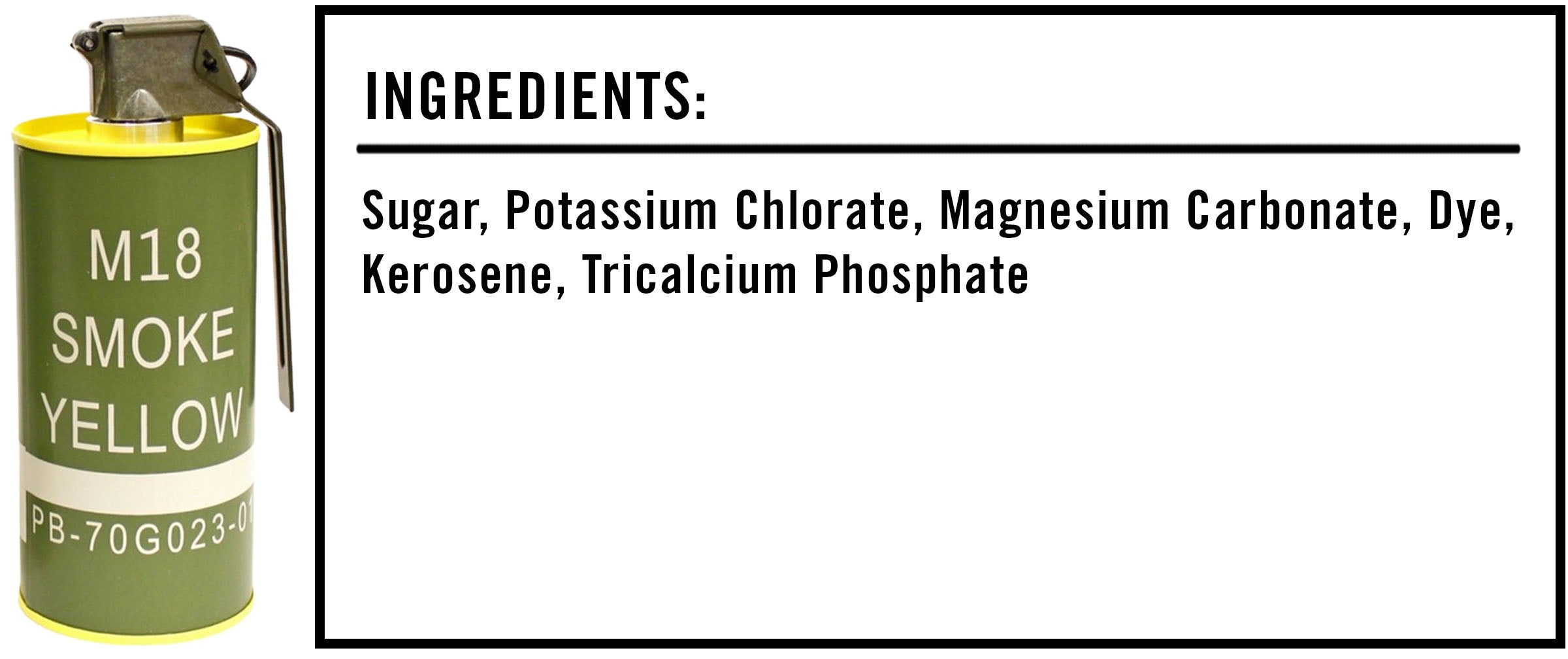We’re often told that you should never eat anything (or put anything on your body) if you don’t recognize everything on the ingredients list. But since most of us have no idea what xanthan gum or potassium benzoate are — or more importantly, what they’re doing to our bodies — we’re decoding the ingredients in the many things Americans put in (and on) themselves.
This edition: M18 Smoke Grenades, which you should definitely neither eat nor put on your body, but hey, this is Smoke Week, so, deal with it. These are made from six separate ingredients that we’ve broken down as they appear in a study that focuses on the 2007 reformulation of these military smoke bombs.

The Ingredients
1) Sugar: While this might be a surprising first entry, sugar is the fuel that ignites these smoke grenades. You see, small sugar particles have an extremely high ratio of surface area to volume, which causes them to burn up almost immediately when exposed to high temperatures. The spark caused by pulling the pin on these grenades essentially ignites the sugar, setting off a small explosion that releases the smoke.
2) Potassium Chlorate: Potassium chlorate is an oxidizing agent — it basically causes a chemical reaction involving the reduction of electrons, and such chemical reactions typically contribute to combustion. In simpler terms, similar to how oxygen can help a fire grow and expand, potassium chlorate essentially adds fuel to the fire that the sugar in these smoke grenades creates.
3) Magnesium Carbonate: This is a coolant, meaning it moderates the rate of the above-mentioned combustion to prevent it from burning out before all the smoke is released. In fact, this is a pretty important ingredient in these smoke grenades, since it keeps the fire burning consistently, which is how so much smoke is produced.
4) Dye: This is what creates the smoke and gives it its color. Yellow M18 smoke grenades, for example, contain a solvent called yellow 33 — a fusion of the organic compounds phthalic anhydride and quinaldine (a byproduct of coal) — which is a bright yellow dye with a green shade. When these grenades ignite, that slow-burning fire I mentioned earlier essentially vaporizes the dye inside which, similar to how a Juul vaporizes the juice in its pod, turns into a huge cloud of colored smoke. In other words, the dye itself becomes the smoke.
I reached out to a friendly source in the U.S. military, who prefers to remain anonymous, who told me that units oftentimes use certain colors to communicate different messages — for instance, red smoke might mean there was a casualty, whereas yellow smoke might advise the soldiers to shift their fire in another direction. However, he also explains that the meaning behind each color can vary depending on the unit, since the military has no comprehensive guide for smoke grenade communication.
5) Kerosene: This is apparently an optional ingredient, which would help the grenade produce more fire and possibly more smoke. It might also control how the smoke disperses.
6) Tricalcium Phosphate: This is another optional ingredient that serves a similar purpose to kerosene: It helps to control the thickness of the smoke.
The Takeaway
As I mentioned earlier, these are a relatively new version of M18 smoke grenades, which were reformulated in 2007 in an attempt to make them safer for both soldiers and the environment. This rethinking mainly involved removing sulfur and sodium bicarbonate, two ingredients that are toxic and can irritate the lungs and respiratory tract when inhaled. They also removed some potentially harmful dyes, although even yellow 33, for example, can still trigger allergic reactions in people who are particularly sensitive. All of which means, while it might sound like a fun idea to throw one of these into your stoner friend’s bedroom and hold the door closed, it could potentially irritate their lungs (and even skin), even more so than that massive bong rip they just took.
Now, if you want to know how much smoke these grenades actually create, here’s a video of some crazy Russian dude throwing one around (you’ll see he’s wearing a gas mask, because again, the smoke can definitely damage your lungs):
Plus, while some smoke grenades are legal for regular citizens to buy and own, M18 smoke grenades are illegal, since the fact that they combust technically makes them an explosive device.
If we’re being honest, that’s probably (definitely) for the best.

